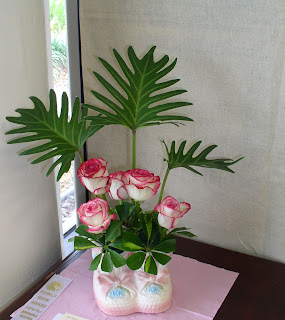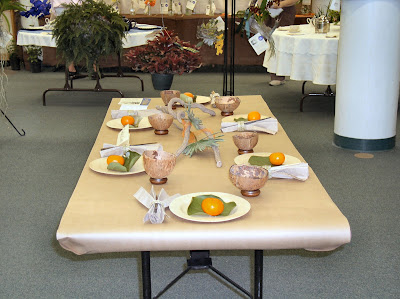The theme this year for the annual “Art in the Gardens” outdoor sculpture installation was “Gators in the Garden.” Schools from throughout Lee County participated and entered their alligators, which were lurking in the grass of the Edison Heritage Truck Garden area near the museum. Teachers were awarded funds to assemble the weather-proof, recycled materials for the sculptures, and the art was up to the students. There were supposed to be 25 schools represented, but on the day I went, May 18, there were about 15 sculptures. The exhibit started on April 7 and continued through May 25, so some of the gators must have "high walked" away.
The Edison & Ford Winter Estates, the Lee County Art Educators and Lee County Schools collaborated to bring the project to fruition. The outdoor sculpture exhibit, now in its fifth year, was supported by the George M. Cox Trust. In addition, there were informational signs about alligators sponsored by Costco Wholesale and Everglades Day Safari. (The Gator Info was taken from the signs.) The exhibit was free to the public--it wasn’t necessary to pay the usual fee to visit the Estates.
A larger-than-life-sized Mina Edison sits on a bench near the entry to the exhibition.
“Art in the Gardens” 2013 sign
Four gators by middle school students from Veteran’s Park Academy for the Arts with teacher Jill Antonucci.
Look closely at this gator--he is covered entirely by seashells.
Gator Info: Adult males and females have an olive brown or black color. Young alligators can be easily distinguished by the bright yellow stripes on their tails.
Gator Info: Adult males and females have an olive brown or black color. Young alligators can be easily distinguished by the bright yellow stripes on their tails.
I don’t know what the “scales” were made of on the alligator on the left, but they gave the gator hide a great texture.
This gator is a great example of flower power.
Gator Info: Female alligators can grow up to 10 feet in length, and males have been recorded at just over 14 feet in length. Alligators have osteoderms, bony plates on their backs, that act like solar panels, warming and cooling blood vessels and helping to regulate the reptile’s body temperature. Alligators have 2 sets of eyelids. One set is like a human’s eyelid and the other set is transparent and applied to see clearly underwater.
The students from Tortuga Preserve Elementary School with teacher Christina Sterrett fashioned this gator from many, many plantings in individual cans.
This gator shows a novel use for living plants and recycled cans.
Edison Park Elementary School students and teacher Karen Flanders did this pink gator made up of lots of paper ribbons.

A close-up of the pink be-ribboned gator
Gator Info: Alligators can burst out of the water toward prey at quick speeds but cannot run far. They most often “high walk, ” keeping their legs almost directly beneath them, as opposed to most reptiles which keep their legs to the sides at a diagonal and “slither.” This "high walk" results in greater elevation, allowing them to lift their tails off the ground. From the looks of it, I think this pink gator is “high walking.”
The alligator from the back.
Wire mesh is fastened to a frame, and each colored strip is laced through the mesh according to the design.
Alligator Mom and babies done by Tice Elementary School students and teacher Jill Kessler
Look closely at the bodies of the gators--they’re made of pails of graduating size.
Mama and babies from the side
Alligator and baby fashioned by students from Challenger Middle School and teacher Sandra Rayannic
Alligator close-up
Baby gator close-up
Hans Marsh Elementary School students and teacher Robert Sherry did this alligator-mobile.
A close-up of the delicately-made mobile
Gator Info: Adult alligators bellow and roar to each other. The bellow is a loud and throaty noise that can be heard from up to 165 yards (farther than a football field.)
A close-up of the delicately-made mobile
Gator Info: Adult alligators bellow and roar to each other. The bellow is a loud and throaty noise that can be heard from up to 165 yards (farther than a football field.)
A view back toward the entrance to the exhibit
This bright green gator was done by the students from Skyline Elementary School with their teacher Liz Beemer. Look closely at the gator’s exterior--it is made completely of plastic bottle tops.
The gator’s nest
This gator was the most menacing. The ridges on its back are made of a household cast-off: an egg carton turned up-side-down. Its head is the base of a palm tree frond turned up-side-down.
Chicken wire covers its body.
I could find no sign to identify the school whose students did this gator. The design is simple but was executed very effectively.
Gator Info: Alligators once numbered approximately four million in the state of Florida. Due to poaching and water management practices, the number declined to more than 10,00 in the 1970s. Today, American alligators are still listed as threatened due to their similar appearance to American crocodiles, which are endangered.Alligators can be differentiated from crocodiles because the alligator jaw is broad and rounded.
Mosaic gators with bottle noses
Varsity Lakes Middle School students with teacher Marjorie Resler did this snappy-looking gator in pink with a black and white top hat. A cane would be a nice accessory for this gator.
Gator Info: Alligators are an important part of the environment for multiple reasons and, therefore, are considered a “keystone” species. They are important because they control populations of prey species; after alligators leave their holes, the burrows become a habitat for other creatures, such as turtles and fish; and alligators are indicators for environmental factors, such as toxin levels in water (measuring mercury using blood samples taken for research purposes) and water levels.
Close-up of this out-on-the-town gator
Gator Info: Alligators can live to well over 70 years due to an excellent dental plan. When one hollow, cone-shaped tooth falls out, another is underneath, ready to grow in its place. Alligators have between 70 and 80 teeth.
This monolith was done by James Stephens International Academy elementary school and their teacher Alisha Koyanis. I wasn’t quite sure what it was, but the frogs on the lily pads were wonderful.
Top of the monolith
Frog on a lily pad
Gator Info: When it is time to eat, alligators are neither hunters nor gatherers. They are lurkers. They wait for something edible to swim or walk nearby and they lunge at it with incredible speed. When lurking in the water, only the eyes and nostrils are above the waterline. An alligator can sit like this for hours waiting for something edible to wander nearby. When its prey gets close enough, the alligator moves with startling speed. Alligators will eat almost anything they can capture -- fish, turtles, frogs, birds, small mammals, and sometimes even larger mammals like deer. The moral of this story: never underestimate the lightning speed of this seemingly slow and ponderous animal.
Kiddie pool and sun chair by the students from Trafalgar Elementary School and their teacher Helen Garcia-Valdez.
All the little gators inside the kiddie pool look like they are parts of some kind of cactus plant.
Gator Info: The American alligator usually lives in a freshwater pond, marsh, swamp, river or lake. These smaller bodies of water are believed to attract American alligators because they are calmer bodies of water which makes it easier for the gator to breathe. In calm waters, the gator only needs to keep its nasal disk above water, but in deeper, rough waters the gator has to keep the snout at a steeper angle to breathe.
A close-up of a baby gator on a moss basket
This is the back part of the Heritage Garden. I have been to the Estates several times in the last few years, but I have never wandered back to this exquisite garden site. Now I’m doubly glad I came to see the gators.
Another view of the garden
“Art in the Gardens” Collaboration Sign















































































































